 The Kingdom of Orr
The Kingdom of Orr
by Magister Thalador Doomspeaker
Foreword
It was almost three years ago when, with the backing of a news agency centered in Lion’s Arch, I published my speculative article on risen Orr. It only appeared in a limited number of copies and – fortunately – it did not go beyond the borders of the Black Citadel and the outlying ranches. While the general purpose of the study was to draw the attention of my kin to the growing threat of Orr and Zhaitan, looking back I am not surprised it was not well received – given the passive support of the Durmand Priory that I got by proxy only through said agency.
And now, three years later I return to the field that started off my scientific career. After becoming a gladium, going through several personal crises before first joining the Priory, and forming a new warband of charr suffering the same fate, I had the tremendous honor of being part of the Pact’s war effort in reclaiming Orr for the living and destroying an Elder Dragon once and for all.
Similarly to my first study, I will go through Orr’s past, present, and future, but in far greater detail and enlightened by the history and lore we recovered among the ruins. I was considering actually publishing all of my journals starting from my arrival at Fort Trinity to the Battle of Arah; however, I felt I would rather not burden the readers with the host of the tormenting memories and the image of the twisted horrors that plagued the dying nation… maybe another day.
Even then, I must speak of the heroes who gave their lives so that we could carry on the fight and return. Too many fell to the depravity of the Elder Undead Dragon, but without their courage, I could neither write down these lines, nor there would be anyone to read them. As such, although the debt is impossible to repay, I offer this study to the memory of every asura, charr, grawl, human, norn, ogre, quaggan, skritt, and sylvari who made the ultimate sacrifice. Orr would never have been freed without them.
Orr, the Jewel of Tyria
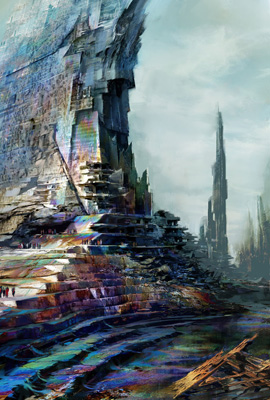
 Originally I made the mistake of calling pre-Cataclysm Orr an arid peninsula, due to never having seen a map of Tyria made prior to 1071 AE. As I delved into historical records shortly after I joined the Priory’s ranks, I could not have been more surprised. Yet it didn't prepare me for the experience of seeing Izz-al-Din Sarayi just off the eastern coast of Orr. The small island was basically unsullied by Zhaitan’s corruption, and save for the sad sight of ruins it was a beauty to behold. It was the first time I was shocked to acknolwedge what was lost to a folly of an insane human and the filth of an Elder Dragon.
Originally I made the mistake of calling pre-Cataclysm Orr an arid peninsula, due to never having seen a map of Tyria made prior to 1071 AE. As I delved into historical records shortly after I joined the Priory’s ranks, I could not have been more surprised. Yet it didn't prepare me for the experience of seeing Izz-al-Din Sarayi just off the eastern coast of Orr. The small island was basically unsullied by Zhaitan’s corruption, and save for the sad sight of ruins it was a beauty to behold. It was the first time I was shocked to acknolwedge what was lost to a folly of an insane human and the filth of an Elder Dragon.
It is still up to debate whether Orr was always an island or it became a peninsula after the Crystal Sea to the east had turned into a desert in the wake of the event known as Exodus. However, regardless of its geographical classification, Orr was a bountiful land with a tropical climate, probably similar to that of Kryta. Its lush, verdant jungles received rain from both the Bay of Sirens (now the Sea of Sorrows) and the Unending Ocean. Beautiful as it was, Orrian waters - especially the northern shores - were hazardous and a challenge to navigate through safely. Even before the Cataclysm, many ships were lost to the reefs and jagged cliffs that crushed hulls in storms. Orrians had to rely on the guiding light of grand, magical lighthouses, called torches, shepherding vessels to the southern harbor of Arah.
We have also learned a great deal of the nation’s flora and fauna even during the war. Cypress forests and special jungle woods covered much of the land, the latter being used in crafting many magical weapons and objects – the source of the trees’ uniqueness probably found in the highly magical waters of Orr. Within their shelter gorillas, raptors, eagles, and other tropical animals dwelled, while Orr’s shores and coastlines provided habitat for drakes and bull sharks. Unfortunately, all of these creatures were twisted into mindless, rotting horrors by Zhaitan.
Orrian farmers grew various crops, including some unique to the land such as the marvelous omnomberries, ghost pepper, lotus, and delicious truffles, while the carnivorous side of the Orrians’ diet was supplied mostly by poultry, cattle, and fish.
There is still one mystery I was not able to find an answer to yet: dragons. It is obvious that Zhaitan slept beneath the southern reaches of Arah for eons, and upon his rise he created his horrible draconic champions that spewed their master’s plague across Tyria’s coastlines. However, the first sighting of undead dragons 250 years ago is still unexplained. During the first undead invasion of Kryta following the Cataclysm, the rotting bone dragons were the most feared elements of the Lich Lord’s army. Many believed that Orr also housed living dragons beforehand, but I found no record that would support this theory. Maybe these abominations were hibernating with Zhaitan the whole time, and the nation’s submergence woke and freed a few, who in turn flocked to the strongest, wakeful source of undeath they could find: the Lich Lord.
The History of Orr, Volume 2
To know the history of Orr is to know the history of Tyria.
The time before the arrival of the human gods is shrouded in mystery. What is known of this prehistoric age is that the magic of Orr was very potent and imbued the land in huge amounts through its immense, artesian well.
It is now established that the foundations of Arah existed before the Six Gods: a quadrant of the city, which later became the Grand Basilica, was built by the serpent race called the Forgotten. It was here that the Forgotten achieved what had been previously thought impossible: they broke the Elder Dragon Kralkatorrik’s hold over Glint, the legendary crystal dragon who was known as Glaust prior to her redemption. With Glint’s help the five elder races survived, and the Elder Dragons fell into slumber once starved long enough by the sudden disappearance of their prey. How or why Zhaitan came to Orr in the first place is either unknown or up to debate; maybe it sensed the magic-rich Source of Orr or discovered that the Forgotten were hiding there. But before it could see to the consumption of Orr and the eradication of its enemies, it had fallen asleep.
Although no date is given at this time, the Six Gods stepped forth onto Tyria at the artesian well now known as the Source of Orr, bringing their mortal children, humanity, with them. While some historians say that it was the artesian well itself, the very font of Orr’s magic, that drew the gods’ attention to Tyria, I personally believe someone or something – like the Forgotten who were said to have been allied with the Pantheon for the most of recorded history – offered them our planet and more precisely Orr as the place of their new home. It is unknown why they had to flee their mysterious homeworld in the Mists, but all indications imply a calamity transpiring there.
While we are starting to learn more and more of these powerful entities, there is still at least one more major contradiction with what we have gathered on human arrival in Tyria. The first records speaking of human appearance in the world are dated to the year 786 Before Exodus, and far over to the southern continent of Cantha. From there, their spreading into Elona and the Tyrian continent only occurred around 205 BE. At the same time, Canthan legends make the earliest mention of gods somewhere around 510 BE, as according to them, the gods ordered the first Lord Emperor, Kaineng Tah, to unite the warring human tribes and form the Canthan Empire. The coronation and the formation of the empire happened in the aforementioned year.
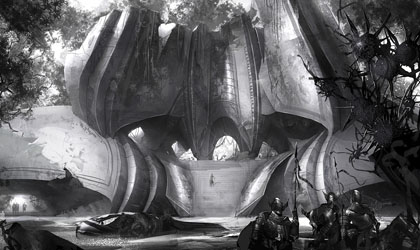
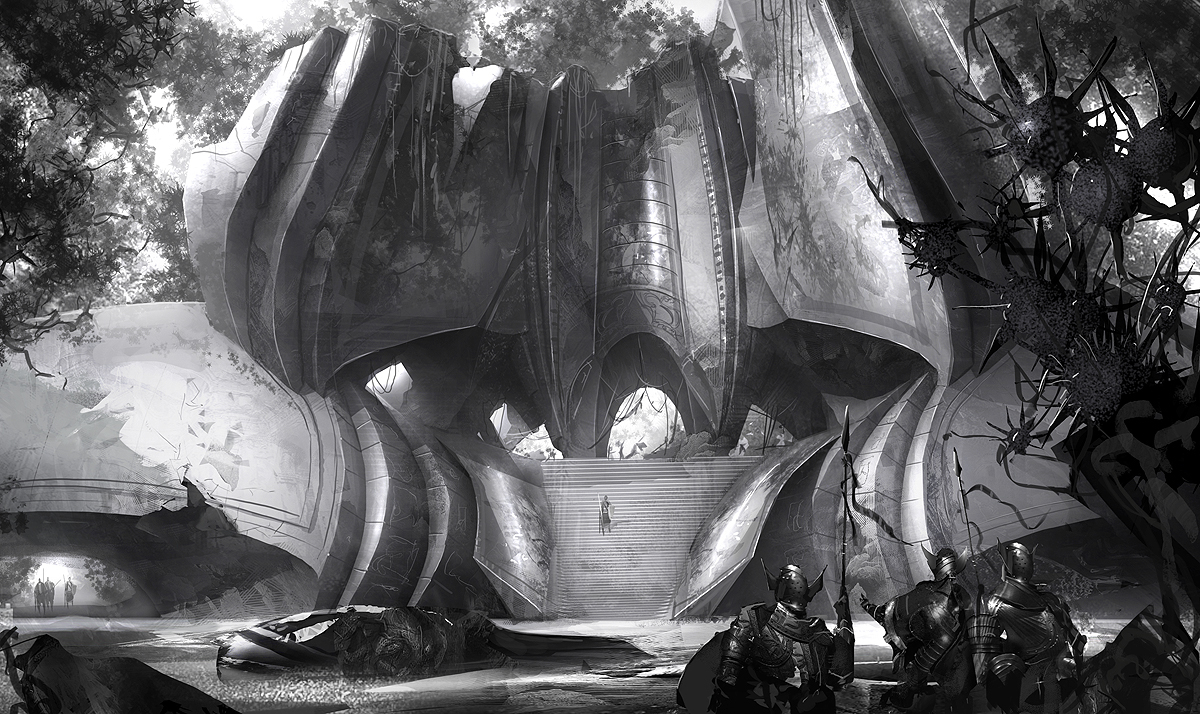 Jumping ahead several centuries, Orr became a thriving kingdom that encompassed the whole of the island after having continuously expanded from Arah, where the deities still resided and collected ancient artifacts from all across Tyria. The Orrian people were blessed, and not only via the pristine, magical waters of the Source that they drank and bathed in, but thanks to their own gods. While all revered and loved their gods above all else, the Orrian nobility formed clergies and turned to a single deity to pray to for his or her blessing. Incredible cathedrals rose all over the kingdom, devoted to one of the Six. Peace was widespread, even when the gods bickered among themselves.
Jumping ahead several centuries, Orr became a thriving kingdom that encompassed the whole of the island after having continuously expanded from Arah, where the deities still resided and collected ancient artifacts from all across Tyria. The Orrian people were blessed, and not only via the pristine, magical waters of the Source that they drank and bathed in, but thanks to their own gods. While all revered and loved their gods above all else, the Orrian nobility formed clergies and turned to a single deity to pray to for his or her blessing. Incredible cathedrals rose all over the kingdom, devoted to one of the Six. Peace was widespread, even when the gods bickered among themselves.
Dhuum, the former god of death, was deemed too harsh and unjust in his treatment of the dead, and so the other Five did not interfere when Grenth, the Prince of Ice and Sorrow, made his move against him. The demi-god lured Dhuum to a trap and overthrew him with the help of seven mortal heroes who became his avatars in the Underworld: the Reapers. After Grenth had ensured Dhuum’s imprisonment, he was allowed by his godly mother, Dwayna, goddess of life and air, to join the others in Arah.
Orr continued to grow in the meantime, its populace steadily increasing. The current king of Orr, the noble Doric, humble devotee of Dwayna, sent his people to the rest of the Tyria with his blessing. One of his sons, Mazdak, traveled to the coastal realm of Kryta with his pilgrimage and built the first settlements there. This long-dead king of Kryta was corrupted into Zhaitan’s servitude sometime after the dragon’s rise. Fortunately, a sylvari Valiant with the help of Caithe ended the sovereign’s suffering not so long ago.
Meanwhile King Doric oversaw the conquest of Ascalon. Blessed by their gods themselves, he and his armies pushed out the charr with ease, and around 100 BE he had himself crowned the king of the newly created Republic of Ascalon. Following his coronation he established a personal union between the province and Orr. This was the height of human dominance not just in Tyria, but the whole of the world as well: King Doric’s empire stretched over the whole continent, the Elonan Primeval Kings were building a prospering civilization from their island home of Istan, and even the Canthan Empire experienced an age without turmoil, even sending ambassadors to the northern neighbors. However, all golden eras must come to an end…
We charr often like to say that humanity’s decline is connected to the exodus of their gods, and that without powerful beings to back them, they are worthless. While it certainly holds some merit – imagine a charr mother pampering her cub for too long and taking it to a fahrar of bloodthirsty whelps – the immediate reason for their weakening is tied to the many follies the Six committed. 1,327 years ago Abaddon, god of secrets and water, gifted not just humanity with a new form of magic, but other races as well, including the charr. This kind of magic had not been seen on the world for millennia, and the sudden introduction of such a staggering power sparked pride and envy in the hearts of most mortal beings. Bloody wars raged across the world, resulting in unparalleled destruction. The humans not only had to withstand the wrath of the races they stamped over in their violent expansion, but they had to struggle against their power-hungry brethren who wanted to claim the human kingdoms for themselves.
When the upheaval began, Doric was either in Ascalon or his summer residence in Lion’s Arch. It is unclear what was transpiring in Orr at the time, but the king had to fight his own countrymen at the Siege of Jumah on his way to Arah. The noble ruler reached the city of the gods, and convinced the deities to take away the fearsome powers they unleashed in order to stop the senseless massacres. Doric gave his own blood and life to shatter and re-seal the ancient seer relic called the Bloodstone; the source of these new magical practices. The sacrifice of humanity’s greatest and earnest king was not in vain, for soon the five shards of the Bloodstone were hidden in a place that no mortal could reach, and the wars finally died down. The human nations survived and came out mostly victorious, but the damage was done: unity was no more.
However, the gods could not get away with the undoing of Abaddon’s plot; the wrath of the maddened god was upon them before they knew it. He rallied his most devoted servants; the seafaring tribe of humans called the Margonites, and stormed the Gates of Heaven in open rebellion. In their brief but apocalyptic battle the Five Gods defeated Abaddon and banished him to his own realm, but the raging traitor did not admit defeat but swore revenge against his kin and all they held dear. Their war was far from over, and the turning of a sea into desert was pale in comparison to what the fallen god of secrets would do to an innocent world in his insane quest for vengeance.
The human gods decided to leave Tyria in the wake of the destruction they caused, albeit it may not have been the real reason for their departure. As they pulled out of this sphere once more, the Orrians took upon themselves the sacred charge of caretaking their home, hoping, or rather believing, that the Five would return one day. At the same time they erased all available knowledge and art of Abaddon, and plunged his Cathedral of Hidden Depths into the sea.

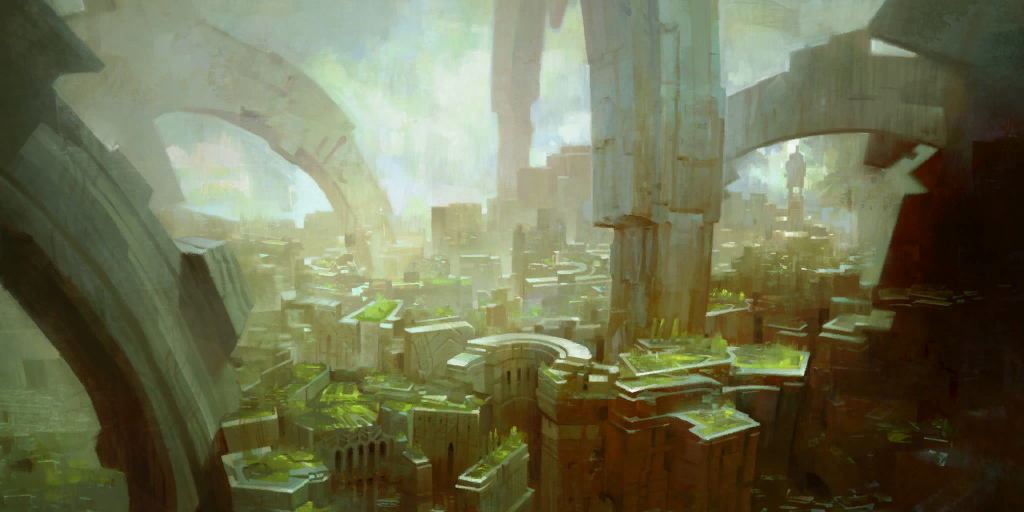
The kingdom of Orr, after its secession from the union in 2 After Exodus, spent the next eight hundred years in absolute prosperity. Out of the citizens of the three Tyrian human nations, the Orrians were still incredibly adept in the arcane arts, yet it felt absolutely natural to them. An Ascalonian merchant visiting the enchanted markets of Wren described their everyday life the best:
The finest silks ripple in the air, showing their quality: songs play themselves on golden lyres; parents project their voices across the square to the find the ear of a wayward child.”
While Ascalon continued to defend itself against constant charr raids and Kryta struggled to rise and shake off the Elonan rule, Orr remained practically undisturbed... until the age of the Guild Wars.
As mentioned before, the five shards of the Bloodstone – four equal but opposing stones of magic, and one Keystone – were placed in the most hazardous place in all of Tyria: the volcano of Abaddon’s Mouth in the Ring of Fire island chain. It remains unknown what transpired within the Mouth (it could've been either due to Abaddon’s machination or a natural phenomenon), but the volcano spewed out the shards and scattered them across the continent. The four schools of magic – Destruction, Aggression, Denial, and Preservation – seeped into the land around them and reignited the desire for power in the heart of men. The guilds of Ascalon and Kryta combined were stronger than the armies of their respective kingdoms and what started out as localized violence between guilds soon escalated into a war between the two kingdoms. Orr, naturally, remained neutral in the face of the conflict through two bloody wars.
However, about two hundred years before the Searing, the Orrian armies were called upon for unknown reasons. Very little is known of this event other than the fact that the commander who led his battalions to the first Battle of Arah was Lord Victo. Not much is known about this man or the battle he fought on the holy streets, but in my original study I suspected that it could have been the first transgression of Ascalonian and Krytan guilds on Orrian soil. On second thought, it could also be tied to Lord Odran’s unholy rituals that he made in attempt to enter the Rift to seek out the gods. Lord Victo died sometime in the mid ninth century, while Odran first entered the Rift in 851 AE. The proximity of the two events is intriguing, as well as the fact that Victo was buried in the Ascalonian Drascir, where the mage lord had also created a portal leading to the Mists.
In 1013 AE the third and last Guild War broke out, but this time Orr was dragged into it as well. There is no actual date given, but when Ascalon and Kryta brought their petty war to the holy City of the Gods, Orr rose to defend itself, escalating the conflict into an all-out war. The number of casualties can give us a good estimate on how powerful the Orrian military was; the death toll exceeded that of the previous two Guild Wars combined.
Orr not only had a nearly unrivaled army, but its armada was far superior compared to the others as well. King Zoran, father of King Reza, led the nation’s navy to prominence, and the kingdom could call the largest fleet of barges and warships of other classes its own. As if it was not enough, Zoran’s benevolence gained him a full corsair fleet as he protected the Elonan corsair, Lady Glaive, and her ships after they had lost to Istan in the Second Great Corsair War. In exchange, Glaive’s pirates defended Orrian vessels instead of preying upon them.
With such navy, army, and magical superiority Orr should have brought the other two kingdoms to their knees, as well as annihilated the invading charr horde. So how did the Guild Wars drag on for 57 years without a decisive Orrian victory? And why did they lose so easily to the charr armies in 1071 AE? The answer lies not only in the savage destruction that the Flame shamans wrought upon the world, but the naïve kindness of the last king of Orr, Reza.
Reza tried to shield his people from the wars, and encouraged a greater focus on spiritualism, magic, and the arts. As a devout follower of the gods, he tried to stop their wayward children from destroying each other in their senseless squabbling, and as such, he tried to bring peace to the three human nations by using his own armies to stop the fighting. It left Orr undefended, and once the charr seared Ascalon and reached the nation from the Crystal Desert, all hope was lost.
The charr leaders, however, had little interest in destroying everything in their path, and made an unbroken stride towards the City of the Gods. The little resistance they encountered was decimated, and in less than twelve hours they were already nearing the Gates of Arah. The reason for this strange behavior lies in the commands of the titans, demonic creatures that the Flame Legion once considered gods and used to enslave all the other charr. The titans were also servants of Abaddon, and the god of secrets wanted to wipe Arah from the face of the world. The Searing cauldrons were all set when the personal advisor of the king, Vizier Khilbron, uttered an ancient litany which defeated the charr forces and sunk Orr to the bottom of the sea.
These last moments prior to the Cataclysm are the strangest of all: why did Abaddon trick Vizier Khilbron via one of his demonic minions to use the Lost Scrolls, when the Searing of Arah was also at hand? Maybe he wanted the death of the whole nation for defying him and destroying his temple? How did the Vizier sneak back into his tower following the theft of the Scrolls from Arah’s forbidden vaults, when there was an entire charr army between him and his quarters? And why were there two cauldrons set up in the immediate vicinity of the Vizier’s tower? Maybe the charr got wind of the Vizier’s plan, and wanted to destroy him before he could read the horrible curse? There are still many unanswered mysteries surrounding the Sinking of Orr, but it is undeniable that the near-total annihilation of such a grand civilization and its populace was a terrible loss… and one that only strengthened the Elder Undead Dragon when it rose 150 years later.
The Undeath of Orr
Zhaitan was not the first to raise the tortured remains of the Orrians, for Vizier Khilbron’s betrayal knew no limit. It is still unclear how did he become a Lich Lord, but in 1072 AE he used his reanimated countrymen to invade Kryta in his pursuit of the Scepter of Orr. Now a sworn ally of Abaddon, his plan was to release the main force of the titans on Tyria through the Door of Komalie and bring the dark god’s return ever closer. Fortunately for the world, Khilbron’s body was slain atop the bloodstone shard in Abaddon’s Mouth and his plan was thwarted. The Vizier was a true survivor, however, as his spirit still persevered at Abaddon’s side in his Realm of Torment, but three years later he was destroyed for good.
The broken isles of the sunken nation stood undisturbed for the next one and a half century, with the only denizens being corsairs and the leftover wandering dead. When the coral-encased ruins rose violently on a sunny day, it all changed, however…
It is unfathomable how – even a dragon of such immense power – made an entire landmass rise in nearly the same way as it existed before its sinking. I would be inclined to believe that the curse written on the Lost Scrolls was connected to the dragon itself, and it simply undid it during its awakening, although this theory will require much more research.
The centuries-old corpses touched by Zhaitan’s essence rose from their watery tombs along with their drowned home, and before the dragon’s conquest began, all the undead flocked to the dragon in Arah, where it had made its lair. The corruption and consumption of Orr began, and Zhaitan first feasted on the many magical artifacts left behind by the gods, while his champions traversed the barren wastes to create more risen out of the massacred inhabitants.
Azabe Quabar, the royal tombs, was the next to fall prey to the dragon’s filth, and the noble queens and kings of Orr became nightmarish horrors carrying Zhaitan’s sight all across its domain. Among them was Reza, the most powerful who assumed the role of the Sovereign Eye of Zhaitan in corruption. Once one of the holiest of men, his transfigured body ventured into the Source of Orr, and poisoned the artesian waters that gave Orr its magic and life.
Zhaitan’s victory over life in the tortured kingdom was almost decisive, and soon his rotten bone ships manned by risen pirates set sails from the ruined harbors of the land, intent on slaughtering the rest of Tyria and bringing it to the dragon’s servitude. For a hundred years did Zhaitan’s reign of terror and undeath go unchallenged, but even an Elder Dragon could not stand against the combined might of our races and the three Orders of Tyria.
The Resurrection of Orr
The Elder Dragon of Undeath roared its last in the skies above Arah, and now its broken corpse lies buried under the tower that was once the home of the human gods. Stripped of its sight and sustenance, its armies in disarray, and its corrupting hold over Orr broken for good with the cleansing of the artesian well, the dragon stood little chance against the MEGA-LIT (mist-cooled tripartate thautmatium energy weapon with a lead tracer array set for draconic energy) cannon of the Glory of Tyria.
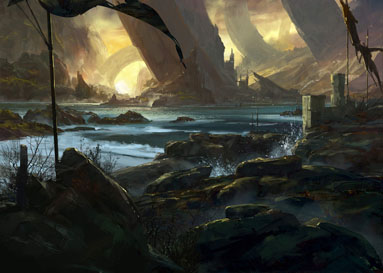
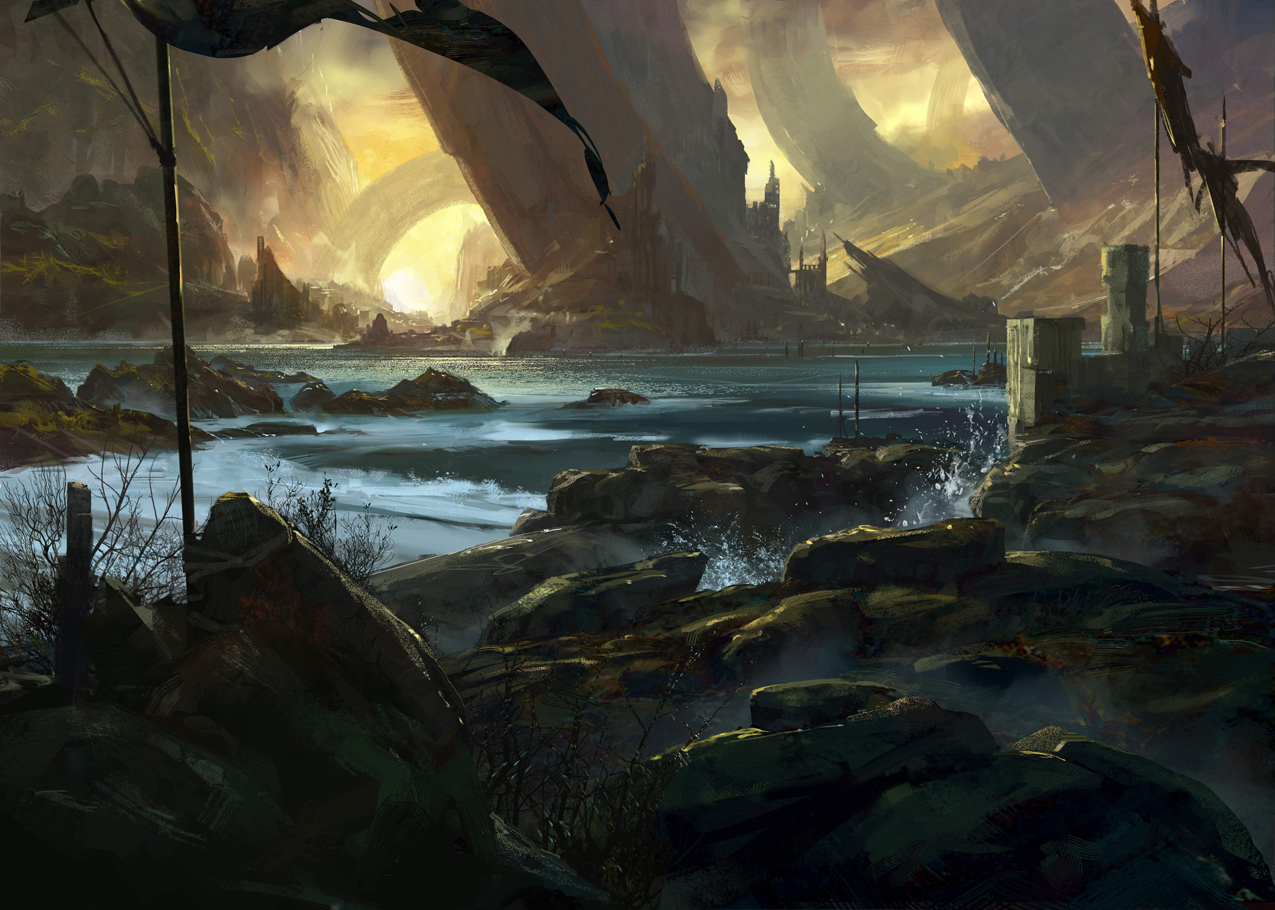 I was fighting on the streets of Arah with a Pact battalion when I heard the ear-piercing roar. For a moment I thought Zhaitan would sweep down swallow and us in whole, but seeing that gigantic, rotten carcass of a dragon plummet back into the hole it crawled out of was a sight for sore eyes. Even though I’m charr, I admit I cried in joy. Now the land of the human gods can heal, slowly but steadily, while the last pockets of risen are released of their torment by indomitable Pact steel. I cannot wait to continue my research in a reborn and rejuvenating land. To see Orr as it was 255 years ago… As my last chapter of this study, allow me to help you show the wonders as they have been and as they will be once more, dear reader.
I was fighting on the streets of Arah with a Pact battalion when I heard the ear-piercing roar. For a moment I thought Zhaitan would sweep down swallow and us in whole, but seeing that gigantic, rotten carcass of a dragon plummet back into the hole it crawled out of was a sight for sore eyes. Even though I’m charr, I admit I cried in joy. Now the land of the human gods can heal, slowly but steadily, while the last pockets of risen are released of their torment by indomitable Pact steel. I cannot wait to continue my research in a reborn and rejuvenating land. To see Orr as it was 255 years ago… As my last chapter of this study, allow me to help you show the wonders as they have been and as they will be once more, dear reader.
The Cathedrals of Orr Possibly the largest, most ornate temples dedicated to the human gods can be found within Orr. Each houses the very first statue made in the image of one of the gods, sculpted over 1,400 years ago by the legendary Malchor. Unfortunately, all six of them were corrupted by Zhaitan, and the risen priests and priestesses who cared so much about tending these shrines in life turned on their respective deities and defaced the beautiful stone images. Now that all temples have been reclaimed, their renovation can finally begin.
The Cathedral of Glorious Victory
Built to honor the war god Balthazar, his temple is situated in the foothills of the northeastern mountainous regions. According to legend, Balthazar was the second to step onto Tyria after Dwayna, bringing along his fierce hunting hounds, Temar and Tegon, as well as carrying his father’s severed head. The god engulfed the land in a cleansing flame upon his arrival, which could imply that Zhaitan’s corruption might have already taken root in Orr during the last rise of the dragons.
The trek to his altar is a serpentine path going along the outer rim of the mountain. At the top the pilgrim is greeted by a gigantic statue of the god of war, challenging countenance, face hidden behind his horned helm, greatsword in one hand, the other covered in flames, with Temar and Tegon growling viciously at his feet.
The Cathedral of Hidden Depths
This forsaken temple now lies in ruins on the bottom of the Strait of Malediction. Condemned to the sea after Abaddon’s fall, the cathedral was basically untouched for more than thirteen centuries. Zhaitan’s corruption had barely scathed it by the time the Pact launched the liberation of Orr, although a powerful, unknown artifact was still lost to the dragon’s servants and most of the temple is caved in now.
Unlike the rest of the Cathedrals, Abaddon’s altar was – true to its name – hidden inside the main structure, and the many defenses of the temple only allowed the worthy to walk its halls. Defeating the image of Abaddon’s many devoted gave the pilgrim an illusory essence that, if placed in special orbs, opened passages leading deeper inside the temple. At the heart stood a mighty statue of the god, showing Abaddon as a noble man deep in thought, his face concealed by his signature mask of six eyes and tentacles, in his hand a mysterious scroll.
Unfortunately, I could not see the cathedral for myself, and only the graceful largos huntress, Sayeh al’Rajihd told me of its wonders. Even then, her description of Abaddon’s visage made me ponder: how could the Secret-Keeper fall so deep from such heights? If we look upon these enigmatic Six as a warband, how could he betray his own brothers and sisters? How could he commit genocide against his own people so many times? I fear that Abaddon’s tale has much more to it than a deadly vengeance born of a misunderstanding, and one day the details of his fall shall be revealed.
The Cathedral of Eternal Radiance
The twin goddess of beauty and illusion - as well as of water and duality - had her cathedral built on the northern shores of Orr at Mirror Bay, just above the huge inlet called the Reflection Cove. Since even the sea surrounding Orr was polluted with Zhaitan’s taint, it is hard to tell whether the water surface was pristine enough to reflect the gigantic disc shape of the temple. All we know is that both the structure and the cove was a beauty to behold, and the latter served as a meeting place for star-crossed lovers.
The layout of the cathedral is that of a mirror, similarly to the Sebelkeh Basilica floating above the Mirror of Lyss in the southern lands of oppressed Vabbi – it is probable the Basilica, which is also dedicated to the goddess Lyssa, was inspired by the cathedral itself. The walkways are arranged in a chaotic, swirling way, surrounding irregular shaped sections that could have only been gardens in their glory. Four main avenues lead from Lyssa’s altar: one to the entrance, two to the shrines of the sisters that make up Lyssa – the Song of Lyss and the Spark of Ilya – and the last to the symbol of their conjoined state, the Seal of Union.
The Cathedral of Zephyrs
Dwayna’s temple, also found on the northern coast, is nestled among the high cliffs overlooking Whisper Bay. In front of it lies the Plaza of Lights, and a grand plane that served as a festive ground during celebrations of King Doric. From the Plaza, two long sets of stairs lead up to her altar, a concentric platform with Malchor’s statue of his beloved goddess rising above the pilgrim.
According to legend, the mortal sculptor was blessed with such a memory that he could recreate the perfect replica of anything or anyone he only glimpsed at. As the divine glory of the human gods was not meant for human eyes, they looked for someone to create their stone images for their followers. Dwayna’s choice fell on Malchor, and the man accepted without hesitation, falling in love with the goddess of life in an instant. One by one, the Six visited his workshop, he glanced at them, sculpted their marvelous statues while his sight continuously faltered. He left Dwayna for the last, but he could only finish her statue once completely blind. The goddess, weeping, let Malchor touch her face so that he might know the precision with which he carved her stone form, but even then, she had to return to Arah, leaving the desperate man who still believed he failed utterly at capturing her beauty. He continued to sculpt more statues of Dwayna, but the more he created, the more he delved deeper into insanity, depressed by his imagined ineptitude. In the end, when he could not take it any longer, he threw himself into the sea from the tall cliff behind his love’s temple.
I was there when my fellow colleague, Vermoth, and bold bunch of heroes and Pact soldiers stormed the altar to cut off Zhaitan’s corruption. It was incredible and terrible at the same time to see that Malchor still lingered on Tyria as a ghost, eternally tormented by his “failure.” His connection was so strong to that statue that he could take control of it and use its powers against us in his last attempt to protect it. With the statue destroyed for good, however, I wonder what will happen to him next? Will he ever pass on to Dwayna’s realm?
The Cathedral of Verdance
Melandru, the goddess of nature and earth and the oldest of the Six was the third god to grace Tyria, and the one credited with turning Orr into a flowering expanse. Fittingly, her cathedral protectively sits on the caverns leading to the Source of Orr, at the southern tip of Winterknell Isle. The golden terraces and lush gardens that once surrounded her serene altar are long gone, however.
I would like to share my dearest experience that is actually tied to this place. On our way back to Caer Shadowfain after Zhaitan’s demise, we stopped to rest at the temple - which was unfortunately destroyed by the Pact in order to flush out the risen forces entrenched there. It was here that I first witnessed life returning to Orr. Possibly the waters coming from the artesian well had their effect on reversing the corruption as well, but I also felt something else… something hopeful as I gazed up at Melandru’ smiling face: and there, running down her stone hair, a liana that was black and decayed when we'd first reclaimed the cathedral was green and blossoming now. I do not know where these powerful beings are now, but I believe they are proud of all of us, and not just the humans, for what we accomplished.
Many of my charr brethren do not know this, believing that these so-called gods wanted to slaughter us and push us out of our lands, but Melandru, along with Dwayna, always strived for peace between humanity and the rest of the world. It is a shame neither their children, nor the world listened to them.
The Cathedral of Silence
Last but not least, the temple of the god born on Tyria. The brooding chambers of Grenth’s cathedral are carved into the mountains of Graven Cay, on the westernmost reaches of Orr. His altar and the Buried Archives rest upon a vast complex of crypts, which made the temple the least affected structurally by the Sinking of Orr.
The Cathedral of Silence, also known as the Shrine of the Seven Reapers, is the oldest temple of Grenth ever built on Tyria. Grenth’s first high priestess, Desmina, and his warrior-priest who carried his worship to Elona, Mausollus, walked its halls.
During my brief visit there, I felt the same feeling that my colleagues spoke of: Grenth and his statues were fighting Zhaitan’s corruption, and while they still could not prevail over the dragon completely, the cathedral was much less corrupted than the previous four. Marshal Trahearne speculated that it might be connected to Grenth and the Elder Dragon having power over the same domain.
The Many Wonders of Orr
It is an impossible task to collect them all here, since most of them have not been properly excavated yet, and a significant portion of Orr is still up for exploration. Here I collected some excerpts from my journals of places I found most intriguing.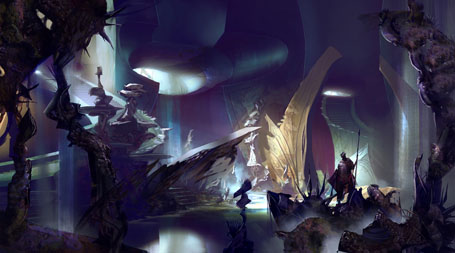
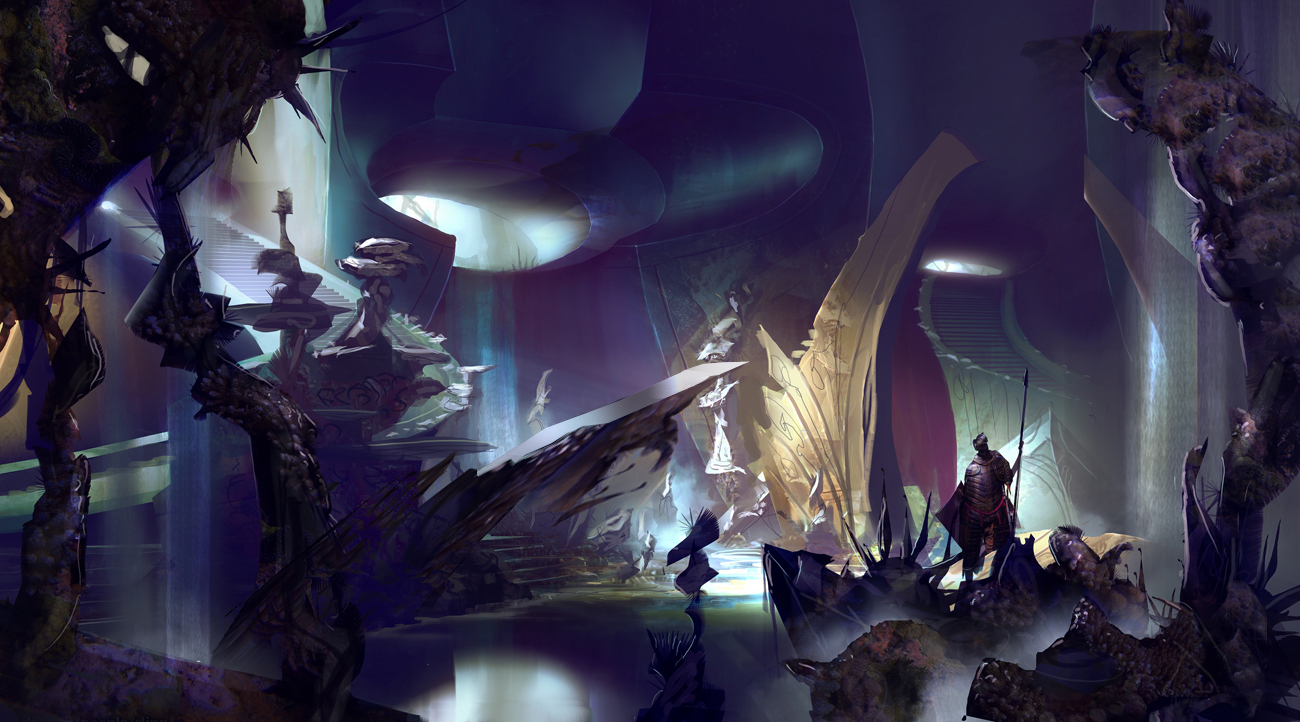
The Vizier’s Tower, Shark Teeth Archipelago
We finally climbed this wretched tower, although it still claimed the life of two. The eroded ledges gave in under their weight.
Being here, on the very spot where the Cataclysm started, is horrifying. I thought it would be a mound of dust and debris, but this place looks fairly intact even now, and the magic of the Scrolls cannot be detected at all. (I wonder what happened to them after the Sinking.)
Not much is left of Vizier Khilbron’s possessions. We found the writings of an earlier Priory Explorer, Mollen, who died here, a marred mural of the fallen god, Abaddon, a ruined vase that must have been beautiful in its prime, and… I am still shaken… a broken mursaat statue. It looks like someone cut it in half in a fit of rage, possibly the Vizier himself. But why? What sort of connection could there be between him and the Unseen Ones?
The Royal Forum, Strait of Sacrilege
We approached the site via submarine, having to blast a few risen sharks to smithereens on the way there. After securing the area, I and a few fellow Pact soldiers dived in. Unfortunately, there wasn't much left of this grand center of the kingdom. At least our exploration was peaceful, since the central and northern invasion forces had long since eliminated most of the risen threat. Only a lone statue of Melandru observed our underwater excavation.
Before the Cataclysm, this place was the very eastern shore of Orr. Ships left and moored at the majestic piers and molos, unloading their exotic cargo which was to be sold on the enormous marketplace or carried deeper inland on huge avenues. Across a now sunken bridge the dome of one of the kingdom's greatest conservatories resided. Inside I still felt the magical vibrations of an experiment long abandoned.
A damned current took me further west along the shore, where I found the banished structures of the Plaza of Lost Wisdom, and the entrance to Abaddon's cathedral itself. I'm glad I didn't stay long, though. Only survived with the skin of my teeth as a risen megalodon decided I was an appropriate course for dinner.
Kitah Manse, Waste Hollows
A horrible place. A Mouth of Zhaitan made its lair here, feasting on many valuable magical objects. Fortunately, now it’s just an unmoving, decayed pulp, and Zhaitan is getting hungrier.
Not much can be told of it, only that the last lord of the estate was a cruel man called Kitah, and he considered himself a devout worshipper of Lyssa. It is even said that the goddess visited the Manse back before the Exodus.
The Wealdwood, Pyrite Peninsula
Impossible. That was my first thought upon seeing the enormous golden orb floating above gilded soil and trees. The magical energies radiated by the sphere are off the charts, yet it has not been consumed by Zhaitan… what’s more, the orb turned corrupted tissue into metal instead! Not just any metal, but gold! Some secluded parts of the dead trees here are still rotten, but those touched by this thing were turned into gold; the complete inner structure as well.
On closer inspection, it seems the shining core is surrounded by a transparent “film” with swirling designs. I hope I live long enough to learn of its origins.
Damn these Inquest fools! They tampered with the orb at night, trying to enchant one of their soul-powered golems (so disgusting, so unethical) with its energies. The result? The golem became gilded as well, turned on its owners, ripped a few to shreds, then started rampaging in the area, killing anything that moved; including several dozens of risen. Strangely, it was shouting ‘Must. Protect. Orr.’ in its weird, mechanical voice most of the time. I would’ve liked to study it further, but Pact command decided to eliminate it - it got too close to Shelter Docks. A human Whispers sniper girl put a slug into its aetheric flux capacitor… Titan’s teeth, I have never seen such a huge mushroom cloud, not even when one of the newest prototype ordnance was thrown into the Great Imperial Smelter back at the Citadel.
This mystery is driving me crazy: a powerful artifact of unknown origins that cannot be corrupted, turns even corrupted material to gold, and alters a soul to kill everyone in the name of Orr’s protection.
Addendum: some colleagues found a similar orb, although smaller, at the wreck of the Golden Vanity in the Harrowed Sea. It looks like it was the ship’s last cargo – maybe they were trying to take it away when all seemed lost. However, this orb is not exhibiting any gilding property. Perhaps inactive?
Bayt Fallahin, Garden of Ilya
Imagine the look on my muzzle when my unit arrived here. The tortured remains of the noblemen and noblewomen of this village (a city, rather, being one of the kingdom's most populous towns) were working side by side with the common folk - tilling and seeing to other hard work most highborn would consider unsavory. After putting them all to rest, we learned from the few remaining log books and journals that the people of this place were exceptionally kind to one another. Every night, the inns and pubs were filled to the brim with both peasants and nobles enjoying themselves. I fear the loss of Fallahin and its people are irreparable.
The Village of Wren, Garden of Ilya
One of the largest settlements in Orr, it must have been beautiful before the Cataclysm. I imagined its markets just like that Ascalonian merchant had described them in his journal, and was left most saddened when I opened my eyes to the ruined visage. Though good thing I did, as a risen was about to jump on me from a tattered roof.
Wren existed from the time before the construction of Arah was finished, and the goddess Lyssa lived here, veiled and hidden, with mortals. Her scriptures even speak of an occasion when she came to Wren in the illusion of a sick, gnarled woman who tried to ask for help from the residents. They all turned her down, save for young woman named Sara. When Sara approached her with the honest intention of aiding her, Lyssa cast down the illusion of plague and revealed her beautiful form. The villagers all begged for her mercy, but she only blessed Sara with her gifts, for she alone saw the true beauty that comes from within. When Lyssa was forced to join the others in Arah, her tears fell like rain on the western road.
Dhuum’s Last Stand, Blighted Arch
The crypts built to the side of the Cathedral of Eternal Radiance gave me the creeps. And not only because the bodies of the holiest followers of Lyssa were used in the creation of the disgusting abominations, but due to that one little spot I accidentally stepped into. It made me tail-twistedly terrified.
Legend says it was the very place where Dhuum was defeated at Grenth’s hand, and where the demi-god took away the god of death’s power.
Doric’s Shrine, Karst Plains
Traversing the shrine of the first king of Orr was a tough skull to crack. Risen worshippers of Dwayna rose at every turn, and we even ran into an Eye of Zhaitan (hopefully it wasn’t Doric himself). None of them could break the Pact's unyielding will, however.
On the far side of the King’s Passage we could rest a little, but our battles were far from over: the Plaza of Lights was a huge complex, and we still had to clear the upper levels.
Sculptor's End, Cathedral of Zephyrs
The brutal battle with Dwayna's statue, possessed by her beloved Malchor, was finally over. Vermoth and I ordered the troops to catch some rest when three human ladies approached us - a Slayer from the Order of Whispers, a Tactician from the Vigil, and an Explorer from the Priory. Fate brought them together, and now they were more than just allies: they were friends. The Explorer told the other two of her Orrian ancestry, and how maidens had used to wreath the very rock of Malchor's fateful leap every year before the Cataclysm. She wanted to honor that tradition after 255 years of hiatus. Although our troops were weary, we roused them up for one more walk.
That extra trek paid off for all of us: as the three of them each placed a flower - a winter sage, a red iris, and a dandelion blossom - on the etched stone, hope was rekindled in all of us. At that moment, these brave, young women were the symbols of Pact unity, and of Pact victory: as we free Orr from the evil of the dragon, we continue to honor the people that once lived here. We marched on, always towards Arah, but with morale higher than ever before.
I hope to see the the three maidens again, a year later at Sculptor's End, with a flower in a hand they picked from a regrown Orr.
Winterknell Labyrinth, Winterknell Isle
A maze of deathtraps and the utter mockery of what it stood for before Zhaitan’s rise. According to my book on Orrian architecture, these mazes served to represent humanity’s struggle through life. So did we fight our bloody way to the center, but instead of the ‘magnificent gardens and magical masterpieces’ waiting us at the center, we found a depraved risen groundskeeper who grew corrupted trees out of the corpses of his victims. The risen monstrosity was cut to pieces along with the trees, but not before it gave us plentiful of nightmare material for the night… or the coming thirty.

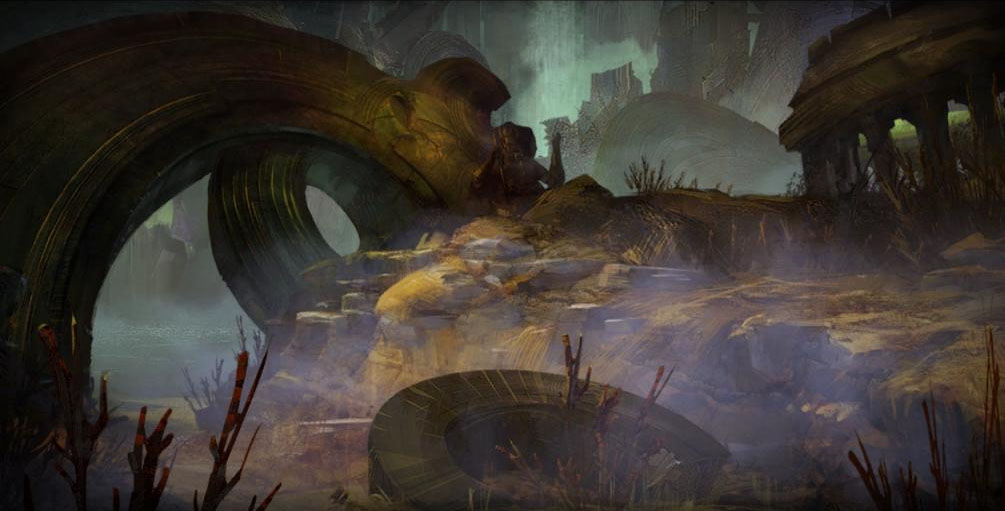
Gallow's Hang, Noose Road
Just like with so many former wonders and breathtaking sights of Orr, Gallow's Hang had been reduced to a sad rubble overgrown with decaying sea life and spoiled by Zhaitan's corruption. Once the cultural and arts center of Orr, now a mockery of everything it stood for.
Hosts of risen Orrians waited the play to begin, with the lead actor and actress being of the nobility itself. As we provided them salvation, I couldn't help but wonder: did these people die like this, waiting for the play to begin? Among the ruins we found several tarnished sets reminiscent of Orr's spired towers. I guess the last performance would've been a national piece... a sad tale, nonetheless.
The Village of Ewan, Craven Blight
I must say I was both surprised and disheartened at current state of this village. Priory records claim that Ewan's village was surrounded by lush farmlands from the Cathedral of Verdance to Compass Plaza, effectively making it Orr's breadbasket. Today they are all but rotten, dialpidated soil, with little (other than the rough edges of the plough lands) to remind the visitor of its former beauty.
My surprise was born of the fact that while this village was named after Ewan, I saw nothing that would imply the events written in Melandru's scriptures actually took place here. According to the legend, in 48 BE there were still pockets of humans in Tyria denouncing the Six as their gods and punishing the use of magic in their midst. One such tribe under the leadership of a man called Ewan wandered the land, laying waste to nature wherever they camped. The goddess Melandru grew tired of the destruction they'd wrought, and so she cursed Ewan and his tribe: they were turned into trees, charged to protect the land as stewards of nature.
I'm not sure what I was hoping for, but I was excited to see those trees, even corrupted. Their absence from the area leads me to believe this particular event of the scriptures happened elsewhere, and the people of Orr simply named this - once - fertile, flowering area in tribute to Melandru and her deeds.
Closure
I reached the end of my knowledge on Orr and now my claws hurt from writing with this pen – charr fingers were not made for this. Orr is being cleansed, slowly but steadily, and years from now it will be a land teeming with life once more.
I cannot wait to return and continue my research into the land of gods. Who knows, maybe my studies will turn into a book once? I certainly hope that this writing provided answers, but piqued your interest enough to thirst for the answers to the many questions raised by the mysteries of Orr. I am counting on you to join us in uncovering those secrets one day, and to see what the Pact achieved through so much pain and blood: a land returned to its former glory. A land seeing dawn once more.